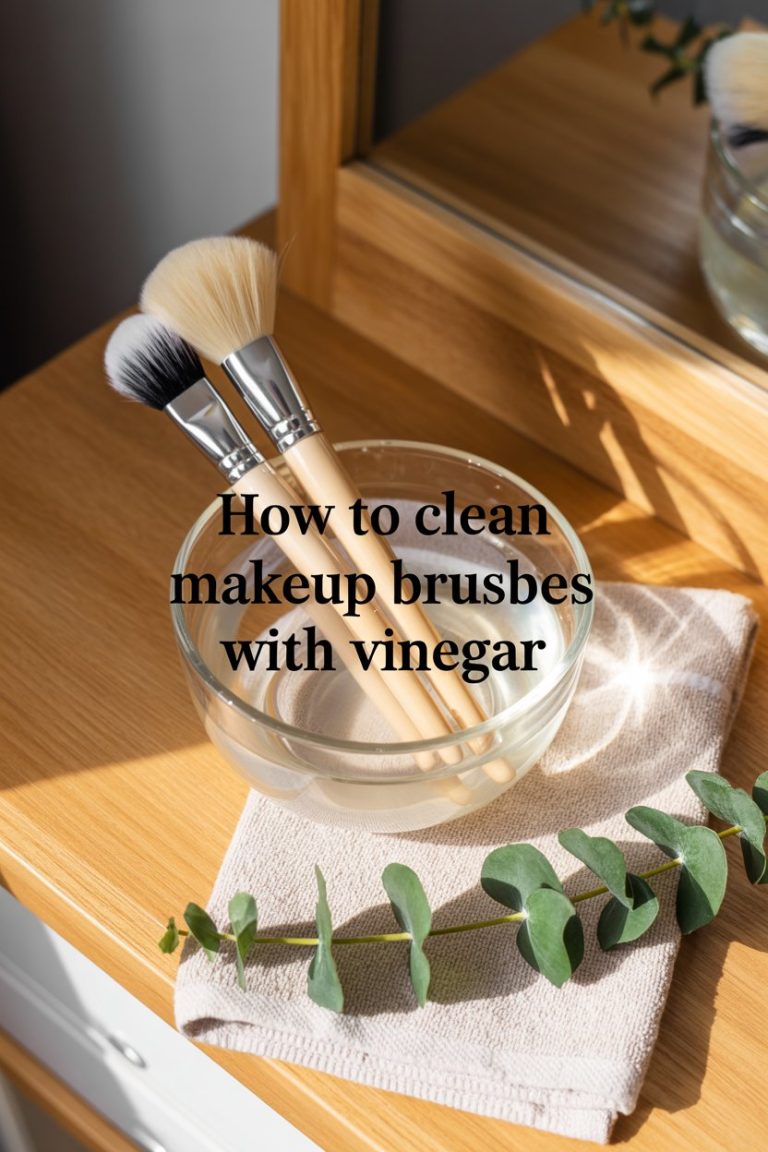Keeping your bathroom faucet spotless is one of those small but powerful cleaning habits that make your entire bathroom look and feel fresher.
Over time, faucets collect hard water stains, calcium deposits, soap scum, toothpaste residue, and even bacteria around the handles and spout. I’ve learned that a clean faucet doesn’t just look great—it helps prevent build-up that can damage the finish and reduce water flow.
In this article, I’ll walk you through exactly how to clean bathroom faucets effectively, no matter what kind you have—chrome, stainless steel, brushed nickel, or brass.
I’ll also share how to remove hard water stains, clean a faucet aerator, and use simple vinegar and baking soda cleaning hacks to make your faucet shine like new.
Table of Contents
- Why It’s Important to Clean Your Bathroom Faucet Regularly
- Step-by-Step: How to Clean Bathroom Faucet Naturally
- DIY Natural Faucet Cleaner Recipes
- How to Make Faucets Shine Again
- How to Clean Different Faucet Finishes
- How to Deep Clean Bathroom Faucet Base
- Bathroom Faucet Cleaning Hacks I Swear By
- How Often Should You Clean Bathroom Faucets?
- Common Mistakes to Avoid
- Final Thoughts
Why It’s Important to Clean Your Bathroom Faucet Regularly
Before diving into the steps, let’s talk about why faucet cleaning matters. Faucets are one of the most-touched surfaces in a bathroom. Between toothpaste splatter, soap residue, and mineral buildup, they can quickly go from sparkling to dull.
Over time, this buildup can:
- Dull the finish, especially on chrome or stainless steel faucets
- Clog the aerator, reducing water pressure
- Harbor bacteria and mold around handles and bases
- Create water spots that are tough to remove later
Regular cleaning—ideally once a week—keeps your faucet in good condition and prevents deeper cleaning sessions later.
Step-by-Step: How to Clean Bathroom Faucet Naturally
Here’s my go-to method for everyday faucet cleaning using gentle, effective ingredients that are safe for most finishes.
What You’ll Need
- Warm water
- Mild dish soap
- White distilled vinegar
- Baking soda (optional)
- A soft microfiber cloth
- Old toothbrush or small cleaning brush
- Paper towels or dry cloth for buffing
Step 1: Wipe Down the Faucet Surface
I always start by wetting a soft microfiber cloth with warm, soapy water (a few drops of dish soap in a small bowl is enough). Gently wipe down the entire faucet—handles, base, and spout—to remove the surface layer of dirt, toothpaste, and soap scum.
Avoid using harsh scrubbing pads or abrasive cleaners, as they can scratch the finish, especially if your faucet is chrome or brushed nickel.
Step 2: Remove Hard Water Stains from Faucet
If you notice dull white spots on the faucet, those are hard water stains caused by calcium and mineral deposits. To remove hard water stains from faucet, soak a paper towel or cloth in white vinegar and wrap it around the affected area. Let it sit for about 10–15 minutes.
After soaking, use an old toothbrush to gently scrub away the softened deposits. Rinse with clean water and wipe dry. This simple vinegar faucet cleaner trick always works wonders for me—it’s eco-friendly and requires no harsh chemicals.
Step 3: Clean the Faucet Handles
Handles are one of the germiest parts of the bathroom. To clean faucet handles, I dip a cloth in the soapy solution and scrub around the handles, focusing on crevices where grime tends to collect.
If you have separate hot and cold handles, lift or twist them gently (if removable) to reach the base where water spots often hide. Then, dry thoroughly with a clean cloth to prevent streaking.
Step 4: Clean the Faucet Aerator
Over time, the aerator—the small mesh screen inside the spout—can become clogged with limescale or debris, affecting water flow. Here’s how I handle cleaning the faucet aerator:
- Unscrew the aerator from the faucet tip using your fingers or a small wrench (wrap the wrench with a towel to avoid scratching).
- Rinse the aerator parts under warm water to remove loose debris.
- Soak the aerator in a small bowl of vinegar for 10–15 minutes to dissolve any mineral buildup.
- Gently scrub with an old toothbrush, rinse, and screw it back onto the faucet.
You’ll notice an immediate improvement in water pressure once the aerator is clean!
Step 5: Polish Chrome or Stainless Steel Faucet
Once everything is clean, I like to polish the faucet for a streak-free shine. For how to clean chrome faucet or how to clean stainless steel faucet, simply spray a bit of vinegar on a microfiber cloth and buff in circular motions.
If the faucet still looks dull, sprinkle a little baking soda on a damp cloth and rub lightly before rinsing and drying. Baking soda is slightly abrasive but gentle enough to restore shine without scratching.
For stainless steel faucets, you can also add a drop of olive oil to a soft cloth and polish for a beautiful, water-resistant finish.
Step 6: Dry and Prevent Water Spots
After cleaning, I always dry the faucet completely using a lint-free towel or paper towel. This last step prevents new water spots from forming and keeps the faucet gleaming longer.
To prevent water spots on faucet in the future, give it a quick wipe after each use or once a day. This simple habit goes a long way toward keeping your bathroom looking polished.
DIY Natural Faucet Cleaner Recipes
If you prefer to avoid commercial cleaners, here are two of my favorite homemade solutions for bathroom faucet cleaning without harsh chemicals:
1. Vinegar and Baking Soda Faucet Cleaning Paste
Mix 2 tablespoons of baking soda with enough white vinegar to form a paste. Apply it to areas with heavy buildup or stains, let it sit for 10 minutes, then scrub gently with a toothbrush and rinse well.
2. Lemon and Salt Cleaner for Brass or Copper Faucets
Cut a lemon in half, dip the cut side in salt, and rub it gently on tarnished areas. The citric acid and salt combination naturally lifts oxidation and restores shine.
Both methods are affordable, eco-friendly, and safe for most bathroom fixtures.
How to Make Faucets Shine Again
After deep cleaning, I love finishing with a polish that keeps faucets gleaming for days. Here’s what works best for me:
- Use a microfiber cloth dampened with vinegar for daily polishing.
- Apply a few drops of baby oil or olive oil for chrome or stainless steel surfaces.
- Buff with a dry cloth until you see a mirror-like shine.
This small step makes your entire sink area look cleaner and newer, even if you haven’t scrubbed the rest of the bathroom yet.
How to Clean Different Faucet Finishes
Not all faucets are made equal. Here’s how to adapt your cleaning method depending on the material:
🪞 Chrome Faucets
Use vinegar or mild soap only. Avoid bleach or harsh cleaners—they’ll strip the finish. A quick vinegar wipe keeps chrome faucets brilliantly shiny.
🖤 Matte Black Faucets
Skip abrasive tools. Use gentle dish soap and a microfiber cloth. Dry immediately to avoid streaks.
🪙 Brass or Gold Faucets
Use mild soap and warm water only. Polish with a soft cloth—avoid vinegar, as it can dull the finish over time.
🌫 Stainless Steel Faucets
Clean with vinegar and water solution. Follow the grain when polishing, and buff dry to prevent streaks.
By knowing what your faucet is made of, you can clean bathroom faucets naturally without damaging the finish.
How to Deep Clean Bathroom Faucet Base
Sometimes, buildup hides under the base of the faucet where it meets the sink. To deep clean the bathroom faucet base, soak a paper towel in vinegar, wrap it around the base, and leave it for 20 minutes.
Then scrub gently with a toothbrush and rinse. This method removes grime that collects from splashing water and soap over time.
Bathroom Faucet Cleaning Hacks I Swear By
Over the years, I’ve found a few tricks that make faucet cleaning easier and faster:
- Use dental floss or a cotton swab to clean tight spaces around the handles and base.
- Apply car wax or furniture polish once a month to repel water and soap scum.
- Wipe after every use—this 10-second habit prevents mineral deposits.
- Use a baby wipe for quick touch-ups between deep cleans.
These easy bathroom faucet cleaning tips can save you a lot of time and effort in the long run.
How Often Should You Clean Bathroom Faucets?
I like to give my faucets a quick wipe-down every couple of days and a deeper clean once a week. If you live in an area with hard water, you may need to remove calcium deposits from faucet more often to prevent buildup.
A consistent routine keeps your faucets gleaming and extends their lifespan—no more fighting stubborn water stains every few months.
Common Mistakes to Avoid
Here are a few things I learned the hard way:
- Don’t use bleach or ammonia-based cleaners—they can discolor or corrode metal finishes.
- Avoid steel wool or rough sponges—they’ll scratch chrome and stainless steel.
- Never soak the entire faucet—moisture can damage seals and internal parts.
- Don’t forget the aerator—cleaning the faucet head regularly keeps your water flow strong.
Being gentle and consistent is the secret to long-lasting shine.
Final Thoughts
Learning how to clean bathroom faucet properly makes a bigger difference than you might think. A sparkling faucet transforms your bathroom from “okay” to “fresh and inviting.”
By using vinegar, baking soda, and a soft cloth, you can keep your faucets free of buildup, shine longer, and look brand-new without harsh chemicals.
I’ve tried every trick out there, but these simple, natural methods work best—no expensive products required. Whether you’re polishing a chrome faucet, refreshing stainless steel, or removing hard water stains, the key is regular maintenance and a few reliable tools.
So next time your faucet looks a little dull, grab your vinegar, your cloth, and five minutes—you’ll be amazed at how much brighter your whole bathroom feels.
Next Reads:
- How to Clean Mold in Bathroom Tiles Naturally & Fast
- How to Clean Bathroom Shower Tiles Easily & Naturally
- How to Clean Bathroom Glass Shower Doors Like a Pro

Emma Vanderlyn is a home enthusiast with a passion for all things natural and eco-friendly. With years of experience experimenting with DIY solutions, she’s dedicated to creating safe, effective, and budget-friendly cleaning recipes that are kind to both your home and the planet. Emma believes that a clean home shouldn’t come at the cost of harsh chemicals, and her easy-to-follow guides make natural cleaning accessible to everyone.
When she’s not whipping up a new cleaner in her kitchen, Emma can be found researching the latest in green living or transforming her space with mindful, stylish decor ideas. She’s here to share her love of natural living and help you create a home that shines—naturally.
